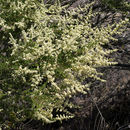More info for the terms:
cover,
forest,
natural,
shrub,
woodlandChamise is a shrub component of chaparral, woodland, and forest
communities throughout much of California [
13,
51]. Within chaparral
communities, chamise typically dominates the shrub cover on the hottest
and driest sites [
102]. As available moisture increases, it codominates
with manzanita (Arctostaphylos spp.) and ceanothus (Ceanothus spp.)
species [
42,
51]. Chamise is an understory shrub in dry coniferous
woodlands dominated by Parry pinyon (Pinus quadrifolia), knobcone pine
(P. attenuata), or gray pine (P. sabiniana). Less commonly, chamise
occurs beneath scrubby "forest" communities dominated by either Torrey
pine (P. torreyana), knobcone pine, Piute cypress (Cupressus arizonica
ssp. nevadensis), Cuyamaca cypress (C. a. var. stephensonii), or Tecate
cypress (C. forbesii) [
51]. It is also present in the understory of
maritime Coast Range ponderosa pine (Pinus ponderosa) forests [
51].
Common associates within chamise chaparral include [
13]:
northern Coast Range: hoary manzanita (Arctostaphylos
canescens), Parry manzanita (A. manzanita), wedgeleaf
ceanothus (Ceanothus cuneatus), wavyleaf ceanothus (C.
foliosus), and leather oak (Quercus durata).
southern Coast Range: oaks (Quercus spp.), ceanothus (Ceanothus
spp.), manzanitas (Arctostaphylos spp.), buckthorns (Rhamnus
spp.), sumacs (Rhus and Malosma spp.), California sagebrush
(Artemisia californica), California buckwheat (Eriogonum
fasciculatum), and sage (Salvia spp.).
interior: whiteleaf manzanita (Arctostaphylos viscida), Parry
manzanita, wedgeleaf ceanothus, Lemmon ceanothus (C.
lemmonnii), chaparral whitethorn, toyon (Heteromeles
arbutifolia), buckthorns, poison-oak (Toxicodendron
diversilobum), and yerba santa (Eriodictyon californicum).
southern California: bigberry manzanita (A. glauca),
Mexican manzanita (A. pungens), pink-bracted manzanita
(A. pringlei var. drupacea), hoaryleaf ceanothus (C.
crassifolius), and desert ceanothus (C. greggi var. perplexans).
Published classifications listing chamise as a dominant or indicator
species include:
The chaparral vegetation of Santa Cruz Island, California [
11]
Vegetation and floristics of Pinnacles National Monument [
36]
Vegetation types of the San Gabriel Mountains [
41]
Preliminary descriptions of the terrestrial natural communities of
California [
51]
Vegetation types of the San Bernardino Mountains [
53]
A vegetation classification system applied to southern California [
102]

